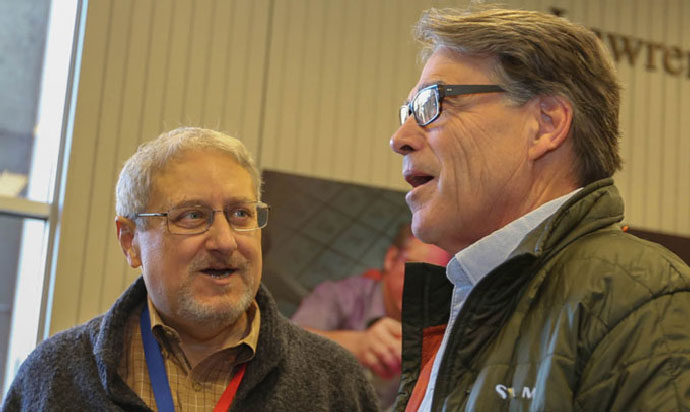Positioning the Laboratory for continuing excellence in science and technology directed at important national missions
FY 2018 was a year focused on engaging with stakeholders and sponsors, providing technical leadership in key mission areas, and building for future successes.
Strategic Engagements and Initiatives
“What you’re doing in a lot of different areas has the potential to change the world,” remarked DOE Secretary Rick Perry to a Laboratory-wide audience in his first visit to the Laboratory in March 2018. Secretary Perry met with many staff members as he toured facilities and praised Laboratory employees for “making a difference in people’s lives.” Director William Goldstein and his management team also hosted visits by DOE Undersecretary for Nuclear Security and NNSA Administrator Lisa E. Gordon-Hagerty and many other distinguished guests during FY 2018. Extensive engagement by Laboratory programmatic and technical leaders is vital for staying informed about and helping to shape the evolving strategic landscape.
The nation benefits from LLNL’s strong technical leadership in many facets of its national security mission. For example, Livermore is the Warhead Design Agency for the Conventional Prompt Strike Program, and the U.S. Air Force is proceeding with an LLNL-developed concept for an air-launched hypersonic strike weapon. LLNL’s capabilities in directed-energy technologies are expected to play a key role in advancing missile defense, partnering with the Missile Defense Agency. Other examples of technical and programmatic leadership, such as in high-performance computing, are described elsewhere in this annual report.
New Facilities and Modernized Infrastructure
Construction of the Advanced Manufacturing Laboratory is completed (see box below, The New Advanced Manufacturing Laboratory). Many other projects are in preparation or underway as part of a more than $600 million facilities and infrastructure construction/acquisition portfolio for the Laboratory. Two of these include the $34 million Expand Electrical Distribution System project (see Safe, Secure, and Sustainable Operations) and construction of a new Emergency Operations Center (EOC) at an estimated cost of $42 million. The EOC Conceptual Design Report was completed in March 2018 and the project is being readied for (Critical Decision) CD-1 review.
Two other major projects are vital to the success of Laboratory missions. First, in FY 2018, NNSA authorized the Laboratory to begin formal design for a construction project to prepare for the infrastructure demands over the next decade of two future exascale systems. The first, El Capitan, will arrive as early as 2023. This machine is being developed by the CORAL consortium (see Nuclear Deterrence ) working with U.S. industry in support of DOE’s Exascale Computing Project. With a current cost range of $57 to $125 million, the Exascale Computing Facility Modernization project at Livermore will upgrade Building 453, where El Capitan will be housed, and construct infrastructure to provide necessary additional power and cooling. El Capitan will provide critically needed computing power for the W80-4 life-extension program and restarted work on a W78 replacement warhead.
The Stockpile Stewardship Program will also benefit from plans to modernize and consolidate engineering design, testing, and certification capabilities through the creation of an Applied Materials and Engineering campus within the main site’s classified area. The five-year undertaking entails upgrades to several existing facilities and construction of two new laboratories and an office building.
Sustaining Workforce Excellence
An outstanding workforce is LLNL’s principal strength. Staff members bring to their jobs impactful new ideas, work with integrity and zeal, and thrive in an inclusive work environment. LLNL ranks 24 out of 100 on Glassdoor’s most recent “Best Places to Work US - Large” list—the top-ranked government/government contractor employer and top-ranked laboratory employer.
Accomplishments, activities, and initiatives highlight staff quality and the importance of recruiting and nurturing future technical and programmatic leaders. One new initiative is the creation of the Data Science Institute (DSI), which brings together myriad topics considered “data science” under one umbrella and strengthens LLNL’s leadership in facets of artificial intelligence and machine learning. DSI serves as a hub for education, seminars, and collaborations and for building a workforce pipeline through programs such as the Data Science Summer Institute internship program. Similarly, the new Advanced Manufacturing Laboratory reaches out to academia and industry, and it helps workforce recruitment in another key research area for the Laboratory’s future.
LLNS Board of Governors Activities
The LLNS Board of Governors and its committees provide oversight to the Laboratory and delve into issues crucial to mission and mission-support activities. External review committees (ERCs), panels of independent experts including Board members, held six meetings in FY 2018 to critically assess the quality of LLNL’s technical workforce and the effectiveness of research efforts in meeting mission goals and future national needs. Their reports, which provided DOE/NNSA with an independent validation of work quality, consistently affirmed the mission relevance and high impact of Laboratory research. Functional Management Reviews (FMRs) chartered by the Board examine issues on an as-needed basis. Six FMRs were completed in FY 2018 in topical areas ranging from cybersecurity to work planning and control. Recommendations provided by Board committees, ERCs, and FMRs have led to substantive responsive actions.







